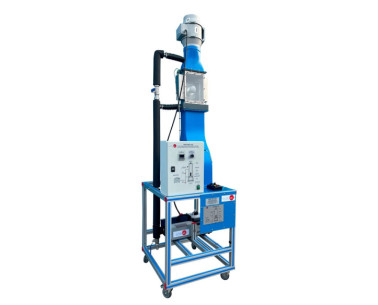The Aerodynamic Tunnel for Flight Demonstration, "TADV225/450", designed by EDIBON, consists of an open wind tunnel in whose working section the model of an aircraft with fixed wings is located. The aircraft is piloted by the user using controls similar to those of a light plane for a realistic simulation of the different flight stages. The different sensors and the extensive control possibilities allow studying the different states of flight, from take-off and landing to level flight, cruise and stall, and the influence of the control surfaces.
In the working section, an aircraft model with two propellers in the front and two wings with a commercial aerodynamic profile is suspended. By means of a manual control system it is possible to control the pitch of the aircraft and an throttle similar to that found in a real aircraft allows to control the wind speed in the working section simulating the acceleration or braking of the aircraft. To guarantee a correct control, the working section is perfectly illuminated and has a wide transparent window to visualize correctly all the process. The sensors located in the working section allow to know the pressure and the air speed, in addition, pitch angle and attitude can be measured by an angle sensor, altitude by a displacement sensor and lift force by a load cell. These values are shown on a display visible to the user while operating the controls.
The air is supplied from an axial fan placed downstream of the working section. In addition, the air passes through a flow straightener before entering the tunnel.
The throttle regulates the rotation speed of the fan allowing to accelerate and reduce the wind speed in the working section.
The plane angle controller allows to vary the pitch angle of the aircraft regulating the ascent or descent of the aircraft. This angle is shown on the display mentioned above. If this angle exceeds a certain limit, the aircraft will stall, drastically reducing the lift force on the aircraft. A locking system on the lever allows to fix a certain position.
The wings of the aircraft follow a NACA-type aerodynamic profile and include several strips on their surface which do not affect the flight of the aircraft but allow the air flow over the wing to be observed. In this way it is possible to visualize the detachment of the boundary layer and the effect of the stall.
Finally, it is possible to vary the weight of the aircraft by means of a set of weights. Morever, it is possible to vary the center of gravity of the aircraft by placing the weights in different positions.
The possibility of varying the pitch of the aircraft and the measurement of the lift force allows to find the lift curve of the profile used and to find the value of the angle of attack for which the stall is produced.
For the Aerodynamic Tunnel for Flight Demonstration, "TADV225/450", there are a number of additional recommended elements (not included) including: Two-Pen Chart Recorder, "TADV225/450-CR", to demonstrate phugoid movement and display small oscillations, and Smoke Generator, "TADV225/450-SGI", to visualize the air flow in the aircraft’s zone of influence.
 Preferências de cookies
Preferências de cookies


















